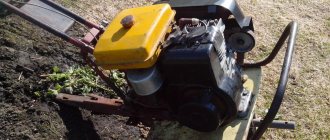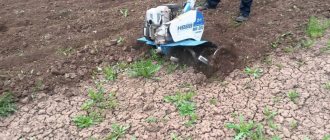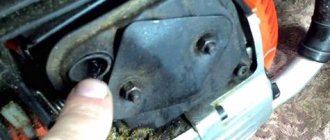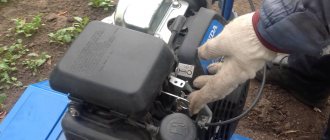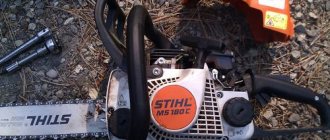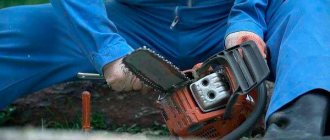Currently, special equipment is used quite often in agriculture and gardening. Here, equipment such as a walk-behind tractor stands out separately. These devices allow you to quickly and efficiently process the soil. However, like any type of equipment, such equipment can also fail. In this case, you need to consider what to do correctly if the Agro walk-behind tractor is faulty and does not start.
There are several reasons why the engine does not work in this walk-behind tractor.
Why the walk-behind tractor won't start - let's understand the reasons
Before the start of the season, both gasoline and diesel walk-behind tractors need preparation.
To do this, the owner of the unit must make sure that the design of the unit contains all the parts necessary for operation, and each of them “sits” tightly in its normal place. Often, many walk-behind tractors equipped with a Subaru engine or engines of other well-known brands refuse to work after a long winter period of inactivity. At the same time, incorrectly chosen storage conditions for an agricultural machine also have an effect - if it has been standing in a cold, damp room, then, most likely, it will not start before the start of spring work. This is due to a number of malfunctions:
- Oxidation of contacts in electrical wiring;
- Violation of the integrity of the wiring insulation;
- Watering of oil and fuel;
- Accumulation of debris in the carburetor jets.
Before starting a walk-behind tractor, its owner must carefully inspect all the connections in the design of the unit. You need to check the movement of the throttle, reverse and clutch cables - it should be soft. If during inspection you find clamps or twisted cables, then you cannot start the walk-behind tractor.
Before starting the walk-behind tractor for the first time, you should check the oil level inside the crankcase. If the lubricant is missing, this will lead to severe damage to the piston group. Judge for yourself: at a crankshaft rotation speed of 1400 rpm, a split second will be enough for it to form several burrs on the surface of the cylinder.
Oil left over for the winter is one of the main reasons for unstable operation of the unit’s motor. It is quite simple to make sure that the walk-behind tractor is difficult to start for this very reason - after starting, white smoke will pour out of the exhaust pipe of the machine for a few seconds, after which the unit will stall.
Do not forget that both diesel and gasoline walk-behind tractors have difficulty starting due to insufficient oil. Some models of units are equipped with low level protection; owners of other machines should independently monitor the volume of oil inside the tank.
Another important factor is the gasoline you use to refuel your walk-behind tractor. If you regularly fill up with fuel of a different brand than that recommended by the car manufacturer, this may also cause the car to not start.
How to avoid breakdowns of the Neva walk-behind tractor?
Every farmer knows how expensive any equipment is, as well as the repair of parts. Of course, if you have extra money, you can afford to buy new components or even new equipment.
But you should still follow simple rules to extend the life of your Neva walk-behind tractor. As mentioned above, before starting work, check all mechanical parts for faults.
Also read the instructions before starting work, where it is described point by point what and how to do. Storage plays an important role. Moisture can cause corrosion in different parts of the unit. Oil and fuel may simply deteriorate.
If you value your equipment, adhere to the storage rules, and also promptly clean the equipment from contamination when working in the ground, as well as from the accumulation of soot on various parts. Don't forget to check the oil and change it on time. And then your Neva walk-behind tractor will serve for many years, delighting you with its excellent condition.
Do-it-yourself troubleshooting
Success in self-repairing a walk-behind tractor largely depends on how correctly you diagnose the unit. The reasons that the walk-behind tractor does not start may be hidden in the following:
- Due to blockages, air does not pass through the air filter;
- The hole in the fuel tank cap is clogged;
- Debris has accumulated in the fuel supply channels;
- Carburetor failure.
Each of these malfunctions is quite easy and quick to fix with your own hands. If this is not the cause of the breakdown, and the unit still does not start, then you should unscrew the spark plug and check for oil stains on it. If you find oil or thick carbon deposits on the spark plug, the part needs to be cleaned and dried. In addition, the cylinder of the walk-behind tractor will also need drying - to do this, you need to sharply pull out the starter cable several times.
It is often difficult to start a walk-behind tractor due to the lack of fuel in the combustion chamber. In this case, the candle will be completely dry. If this is the cause of the breakdown, then the following measures will need to be taken:
- Completely drain the old fuel;
- Thoroughly rinse the fuel tank;
- Clean the air filter from blockages;
- Blow out the fuel supply hose with compressed air;
- Blow out the carburetor jets;
- Fill the tank with fresh gasoline;
- Open the fuel tap;
- Blow out the breathing passage inside the fuel tank cap.
Before restarting, you will need to manually prime the fuel by pressing the fuel pump primer several times. After starting the engine, be sure to give it time to warm up, after which you can start working with the walk-behind tractor.
If all of the above steps did not help, and the walk-behind tractor still does not start, then check the intake and exhaust valves - if they do not fit tightly to the seats, the parts will need to be adjusted by turning the corresponding screws clockwise.
Also, if the walk-behind tractor does not start, we advise you to pay attention to its muffler - after prolonged operation, carbon deposits accumulate on its walls, which must be regularly removed using compressed air.
Repair sequence
1. Check the integrity of the wire running from the button (On / OFF) on the walk-behind tractor control levers to the spark plug.
Checking the integrity of the wire
2. Remove the spark plug and clean the contact with sandpaper. Check the gap between the contacts.
Unscrew the spark plug
When I was assembling the walk-behind tractor and cutters, I left the keys in the box and forgot, so for a long time I looked for the ring wrench that was included in the kit.
Having unscrewed the spark plug, I discovered carbon deposits - apparently the quality of the gasoline is not very good.
3. Screw the spark plug back in.
The walk-behind tractor does not start - we bleed the fuel supply system
A murmur was heard in the tank. After this operation, the walk-behind tractor sneezed and started up.
I think that the fuel filter still needed to be washed, because... there may have been a blockage in it that was blocking sufficient fuel from entering the combustion chamber. In any case, at the moment the walk-behind tractor has started up and is working, and I hope you will also be able to start the walk-behind tractor if it doesn’t start for you. In my case, the walk-behind tractor did not start even after stripping the spark plug. So I opened the fuel wire flap and blew into it .
The easiest ways to revive a walk-behind tractor:
and can occur with both old and new equipment. In this case, you will need to troubleshoot the engine of the walk-behind tractor.
One of the possible reasons is the absence of a spark between the electrodes or its breakdown (breakdown). In this case, it is necessary to replace the spark plug with a new one.
If there is a spark, but the engine does not start, check the spark plug insulation. If the spark plug gets wet, the tip (or rather its insulator) may be faulty. Remove the screen and install a new tip.
A frequent failure of a walk-behind tractor is popping noises and the emission of flame from the muffler (the engine does not start). The reason for this may be deformation of the flywheel key. Replace it by disassembling the starter ratchet. Open the clutch housing, remove the flywheel, remove the old key, install a new one and tighten the housing.
If the starter cord is pulled out without effort when starting, the cylinder seal may be worn out or the gasket between the filter and carburetor may not be installed correctly. To resolve, replace the seals and check that they are properly secured.
The walk-behind tractor also stalls after winter or after a long period of inactivity. In this case, gasoline does not enter the carburetor. The cause of the malfunction is the locking needle. Sediment and tar formations accumulate near it and prevent it from opening when the engine starts.
Poor quality or inappropriate gasoline may cause engine malfunction. In this case, the spark becomes wet and requires replacement of the tip. If you notice an odor uncharacteristic of fuel, replace it. What if the walk-behind tractor starts poorly and stalls?
After starting, the walk-behind tractor periodically turns off with popping noises. Make sure the spark plug is dry. If a conductive substance appears on it, this may cause a lack of spark between the electrodes. The spark plug can be replaced with a new one or the old one cleaned. To do this, it is washed, blown and calcined.
The engine started for a few seconds and then died again. Check the permeability of the sump. If the faucet is clogged, it needs to be blown out and cleaned (using gasoline). Water may also get into the fuel. In this case, you need to drain it and fill in a new one.
There is no spark on the walk-behind tractor - let’s look into the problem
Another common reason that a walk-behind tractor will not start is due to a problem with the unit’s ignition system.
Faults may be hidden in the cap, magneto, spark plug or high-voltage wire of an agricultural machine. When inspecting the ignition system, first of all you need to carefully check each part for blockages. If the spark is lost, the reason for this is often moisture or dirt getting on the elements of the ignition system. Also, often an agricultural machine does not start due to the inability to form a spark - the reason for this is poor contact between the central electrode and the spark plug cap.
If you do not find dirt or moisture in the ignition system, and the walk-behind tractor does not start, then be sure to check the integrity of the electrodes and the gap between them. As a rule, a special probe is used for this. Ideally, the gap should be 0.8 mm. If necessary, remove carbon deposits from the insulator and metal elements of the ignition system.
If the unit does not start, and none of the above procedures helped, then you will need to replace the spark plug of the walk-behind tractor. The cost of replacement parts is low, but when purchasing, we advise you to give preference to more expensive spark plugs - they will last many times longer than their cheaper counterparts. All of the methods listed are suitable for repairing motoblocks Krot, Neva MB-1 and MB-2, as well as Cascade, Zubr, Agro and Salyut.
Rules for operating walk-behind tractors and how they affect startup
Manufacturers do not report the service life of their walk-behind tractors, reasonably stating that it depends on the conditions and intensity of use. This is true, but these conditions also influence in some way how the internal combustion engine starts.
Dirt can get into the carburetor in only two ways - with fuel and through the air filter.
Therefore, the filter must be cleaned or changed promptly. Different walk-behind tractors use filters of different shapes and designs. As an example, replacing a filter on a Scout walk-behind tractor:
There are always fuel strainers in the tank, tap or in front of the carburetor (depending on the model). Just dirt, sand, etc. They can't get into the carburetor.
Low-quality fuel may contain tarry and oily inclusions that form clots in the cavities of the carburetor, carbon deposits on spark plugs, they pass through the mesh and settle inside it. They do not burn out in the combustion chamber and form carbon deposits. Therefore, you should try to use high-quality fuel from proven gas stations.
It is not recommended to use “old” gasoline that has been sitting in a canister for a long time.
Other violations of operating conditions: overheating, lack of or poor-quality oil in the crankcase, operation at the power limit lead to rapid wear or breakdown of the entire unit. This has virtually no effect on how the engine starts.
Why the walk-behind tractor won't start, there is no ignition and the spark is gone, how to start a walk-behind cultivator - reasons
If you are looking for the optimal price-quality ratio, we recommend that you pay attention to the domestic Mole walk-behind tractor, which has been produced since 1983. The walk-behind tractor is still produced today in the Moscow and Omsk machine-building plants. In recent years, high-quality technical characteristics have allowed it to successfully compete with many foreign units. But there are also times when you don’t know why the Mole walk-behind tractor doesn’t start, or it doesn’t start well, or there’s no spark in it. Maybe the starter needs repair, or maybe the ignition is not working properly. In general, this issue and the reasons should be carefully examined.
Preparing for launch
Nuances - if a particular internal combustion engine operates unstably at idle, the start is carried out with the gas handle depressed (the throttle valve is slightly open, the gas is a third or half).
You can find out in detail how to properly start a walk-behind tractor in the video:
When starting a hot engine, the air cleaner damper is not closed at all. There are no “choke” buttons or manual fuel pumping on the carburetor in four-stroke engines. The fuel-air mixture begins to flow (sucked) into the combustion chamber during rotation from the starter without preliminary pumping, which is used on almost all two-stroke single-piston internal combustion engines.
The device of the Mole walk-behind tractor
Motoblocks, which were characterized by simplicity of design, began to be produced more than forty years ago. The first models were equipped with an insufficiently powerful engine and could only be used in a narrow range of jobs.
The first buyers of Mole were not very happy with the insufficient power of the power unit; as a result of numerous complaints, they began to improve the walk-behind tractor. Today, the Mole model is the most successful and versatile model of domestic cultivators among all those on the market.
Small in size, it can be used for various purposes: weeding, loosening, harrowing, leveling. The walk-behind tractor can be used even on a small plot of land, the area of which does not exceed 10 acres.
Walk-behind tractors Krot, Carver, Champion, Plowman, Profi, Huter, Don, Sadko can be used with a diverse line of additional attachments.
As standard, you will be provided with a coulter and a cutter for the Mole. Additionally, you can buy a plow to plow the land and a potato digger.
What are the main advantages of this unit?
- simple design,
- high efficiency,
- affordable price. This contributed to the fact that the model became incredibly popular among domestic buyers.
- There is nothing superfluous in Mole, thanks to which he regularly copes with all the tasks assigned to him.
For more information about the operation of the Mole walk-behind tractor, watch the video:
Device and main characteristics
The MB 2 device is very popular these days; it is simply irreplaceable in agriculture. This line of Kompakt walk-behind tractors is produced under the same brand, but has a difference in the engine:
- “Neva” with index 2K is equipped with a domestically produced motor, so the price of such a device is much lower than that of foreign analogues;
- the second 2B abbreviation indicates that this mini-tractor has an imported engine;
- the abbreviation 2C denotes professional elements in the structure of the apparatus that are used for cultivating the land.
The characteristics of the motor should be taken into account when choosing a unit in order to successfully cultivate the required amount of land, be it tens of acres of land or a much larger area. The design of the unit is the following system.
- The gear-chain type gearbox is located in a specialized case made of aluminum. Its main task is the high speed of the unit. The device has four forward gears and a pair of reverse gears to carry out the revolution. Its maximum speed is 12 kilometers per hour, so this device can even be used for transporting goods.
- To start this small tractor, a motor with a starter is used.
- The frame, which acts as a support, has special fasteners, which are located at the back and front and are used as devices for working in weight.
- There are certain levers on the steering device that are used during operation of the mini-tractor.
- The V-belt type transmission produces the transmission of the clutch assembly from a pulley, a special lever and a V-belt.
- The unit is compact and lightweight, even the very heavy version weighs only 97 kilograms. This device can be easily transported anywhere, even in a regular car.
READ What kind of oil to pour into the Motor Sich walk-behind tractor
The unit with the abbreviation MB 2 has enormous capabilities; it can perform a large amount of work in agriculture, such as: plowing, cultivation, planting seeds, the process of hilling and weeding between rows and harvesting. Neva produces all this using a large selection of equipment that is used in mounted form, as well as thanks to a large number of innovations. The technical features are presented by the Neva MB 2 apparatus as follows:
- It is recommended to refuel the unit only with gasoline;
- hardware power 7.6 l. With.;
- Russian DM-1K engine, a 4-stroke engine with a single cylinder;
- there is an engine with a volume of 317 cubic meters;
- the engine is started manually;
- air and liquid cooling;
- tank volume 2.8 l;
- gear, chain editor;
- fuel consumption is 2.9 liters per hour.
Other characteristic features are:
- during cultivation the grip is 160 cm;
- the depth of the earthen area is 16-26 cm;
- tractor length 1750 mm, height 1350 mm, width 630 mm;
- This mini-tractor can handle about twelve acres per hour.
How to set the ignition
You can set the ignition using these methods.
Use a strobe
- It is worth warming up the engine to a temperature that is optimal for operation.
- Connect the power supply of the strobe to the walk-behind tractor network.
- The sensor that is responsible for the triggered sound must be placed on the high-voltage electrical wire of one of the cylinders.
- Remove the vacuum correction hose and plug it.
- The strobe light must be pointed at the pulley.
- Start the engine, the speed should be idle.
- Rotate the distributor housing.
- Create a fixation during which the pulley mark will reach the required mark on the cover of the device.
- Secure the fastening nut.
Using the lamp
- It is necessary to turn the crankshaft to a position during which the pulley mark will reach the required mark on the gas distribution mechanism, while the slider responsible for interrupting and distributing the ignition should point to the high-voltage wire of one of the cylinders.
- Reduce the force that secures the distributor housing nut.
- Connect one of the wires of the control lamp to a metal wire that serves to transmit electric current that goes from the switch-distributor to the ignition coil, and the next wire to the “ground” of the walk-behind tractor.
- Be sure to turn on the ignition.
- Rotate the body of the mechanism that determines the moment of formation of high-voltage pulses in the ignition system in the clockwise direction until the lamp stops burning.
- Slowly turn the breaker-distributor in the other direction.
- Create a fixation for the breaker-distributor, and the control lamp should light up.
- Tighten the nut that secures the distributor.
With a spark
- The crankshaft should be turned to a position during which the pulley mark will be identical to the same mark located at the base of the gas distribution mechanism, and the interruption-distribution slider will point to the high-voltage wire of one of the cylinders.
- Reduce the locking force of the nut, which preserves the body of the mechanism that determines the moment of formation of high-voltage pulses in the ignition system.
- From the cover of the mechanism that determines the moment of formation of high-voltage pulses in the ignition system, it is worth removing the high-voltage wire, which is located in the center, and its contact must be placed at a distance of 0.5 cm from the “ground” of the walk-behind tractor.
- Don't forget to turn on the ignition.
- The body of the mechanism that determines the moment of formation of high-voltage pulses in the ignition system should be turned 200 clockwise.
- Slowly turn the mechanism, which determines the moment of formation of high-voltage pulses in the ignition system in the other direction.
- The position of the mechanism, which determines the moment of formation of high-voltage pulses in the ignition system, should not move. In this case, a spark will occur between the contact of the wire that is located in it.
- It is worth tightening the breaker nut.
You can hear him
- Turn on the motor.
- Loosen the nut that secures the distributor base.
- Slowly rotate the interrupter housing on both sides.
- The position of the mechanism, which determines the moment of formation of high-voltage pulses in the ignition system, must be fixed in the position when the engine power is most stable and the speed reaches the maximum level.
- The breaker body must be turned clockwise.
- Secure the distributor fastening element.
How to start after winter
After winter, the walk-behind tractor engine starts in the same way as after short breaks in operation. The procedure is described above.
But there are nuances. If there is no fuel left in the carburetor, several pulls of the starter will be required. During the first attempts, fuel is pumped into the carburetor, and only then will it begin to flow into the combustion chamber.
There is also a small chance of condensation moisture appearing. If the gas tank was empty, due to sudden temperature changes, if there were any during the winter, some water may form at the bottom. The same thing can happen in the carburetor.
Therefore, to speed up startup and remove stagnant deposits, you can use the following technique:
The walk-behind tractor should be stored indoors, especially in winter. Rainwater does not penetrate into the nodes as much as melted water from snow and ice. Ice and snow melt gradually, and water can seep into all components, even relatively sealed ones. In some units this will cause corrosion and wear of rubbing parts. And in the ignition system, the coil and electronic elements from water can fail even before the test run in the spring.
How to start a walk-behind tractor after inactivity:
There are many different walk-behind tractors, all of which can vary greatly in design. And even walk-behind tractors of the same model have their own characteristics. Having studied his unit and properly maintained it, the owner gets rid of problems using this equipment.
Source
Malfunctions and causes
If the Mole, Forza, Viking, Crosser, Foreman, Texas, Patriot, Cayman walk-behind tractors do not start and stall or there is no spark in the ignition system, this means that you did not carefully monitor the engine ignition system. You should conduct weekly:
- Control.
- Visual inspection.
- Measuring the distance between the spark plug electrodes and checking the set stage of magneto sparking. For these manipulations, a probe is required.
Ignition malfunction is the most common breakdown that occurs in the Mole walk-behind tractor.
What should you do if your walk-behind tractor does not start and the ignition system of the Mole walk-behind tractor does not work:
- First you need to check the spark plug. Unscrew and inspect it. If you need a separate spark plug for a mole walk-behind tractor.
- Installation of the spark plug must be carried out by first installing the sealing ring, screw it in by hand until it stops, and then use a spark plug wrench. When tightening, do not apply excessive force - this may cause the cylinder head threads to break.
- If the spark plug is dry, it means no fuel can get into the cylinder.
- If fuel drips from the spark plug, it is necessary to “bleed” the engine using a manual starter, this way you will dry the cylinder.
- If there is a lot of carbon on the candles, it should be cleaned with small sandpaper and gasoline.
- Place a square of wire on the spark plug and firmly squeeze the base of the spark plug towards the cylinder, wrap it with electrodes in the direction opposite to the hole. It should be located under the candle at the base of the cylinder.
- Rotate the engine crankshaft several times. The starter cord will help you with this. If the ignition system is working correctly, you will see a sky-colored spark with a white tint between the spark plug electrodes. If it is missing or it varies in color, this indicates that the ignition system is not working properly.
Engine system malfunctions during startup
If, when checking the spark plugs, they turn out to be wet, i.e. fuel flows normally, but the engine does not start, the problem may be the following:
- Ignition system failure:
- Air leaks through carburetor seals, spark plugs, plug and cylinder heads, as well as carburetor and engine cylinder connections.
If depressurization of connections is detected, it is necessary to tighten the mounting bolts, tighten the spark plugs and check the integrity of the gaskets between the spark plug heads and the cylinders.
- Incomplete closing of the carburetor air damper.
To eliminate this problem, it is necessary to ensure free movement of the damper by monitoring the quality of the drive. If jams are detected, they must be eliminated.
Compression failure and carburetor problems
It happens that the launch is carried out, but the process is significantly difficult. At the same time, it works extremely unstable and cannot develop sufficient power for normal operation.
The reason for this may be loss of compression, which can be identified by:
- carbon deposits on the working surfaces of valves, as well as cylinder block seats;
- intake valve deformation;
- wear of piston rings.
In order to restore compression, you must:
If during engine operation black smoke comes out of the muffler, and excess oil is detected on the electrodes of the spark plugs or they themselves are covered with soot, this means that:
- a supersaturated fuel mixture is supplied to the carburetor;
- the sealing of the carburetor fuel valve is broken;
- the piston oil ring is worn out;
- clogged.
To resolve this issue you should:
- adjust the carburetor;
- replace a leaky valve;
- replace worn piston rings;
- Clean or replace the faulty air filter.
If, when the engine is running, light smoke comes out of the muffler, and the electrodes of the spark plugs are dry and covered with a white coating, this means that a lean fuel mixture is entering the carburetor. This problem is eliminated by adjusting the carburetor.
Repair if the walk-behind tractor does not start or stalls
If your ignition does not work, the Mole walk-behind tractor does not start, and you want to repair the electronic ignition, check the stator and magnetic flywheel shoe.
Also check the distance between these elements, which should be from 0.10 to 0.20 mm.
The chainsaw is powered by an internal combustion engine. This is a simple device, the design of which does not have any special bells and whistles. Here you will learn how to start a chainsaw.
To prevent snow from becoming a serious problem for you, you should use snow removal equipment. Champion snow blowers provide excellent quality for many years.
Tractors were successfully used in agriculture on collective farm fields, in cowsheds, and for cleaning city streets by utility companies. Here is all the useful information about the Uralets mini tractor.
To set the gap between the stator and the magnetic type shoe:
- remove the fan housing;
- loosen (but not all the way to the base) a couple of fastening bolts;
- mount the probe plate into the distance between the stator and the flywheel shoe, tighten the bolts that are fixed so that the plate passes within this distance;
- turn the flywheel and pay attention to the gap that was built in around the entire perimeter.
After the gap has been set, it is worth paying attention to whether there is a spark on the “ground” of the housing:
- remove the spark plug square from the high-voltage cable and attach the freed edge at the base of the cylinder with a gap (0.3...0.5) cm between the head and the part of the cable that is not insulated;
- Using the starter, rotate the crankshaft, and a spark should appear, which ensures a breakdown of this gap.
If there is no spark, the starter should be replaced immediately. If a spark appears, it is necessary to check the contact of the high-voltage wire in the spark plug bracket or replace it.
The most common ignition defects:
- Breakdown of the end part of the starter spring at the point of contact with the drum.
- The starter cord is broken.
- Malfunction in the ratchet mechanism.
An unusable spring can be replaced or, if you have the necessary tools and knowledge, it can be easily restored.
To do this, it is worth annealing the end part of the spring at a distance of (10...12) cm on a simple burner using a file.
It is necessary to make the same profile for connecting the spring to the starter drum. Wind the spring onto the latter in the clockwise direction so that its unused edge is engaged and inserted into a specific mounting location on the fan housing.
Center the starter drum using the appropriate screwdriver. The claws (whiskers) of the restrictions must be adjusted to the fan housing, then cock the drum with the spring.
Fully release the spring that is charged several turns and connect the holes of the fan housing and the drum starter; all adjustments must be carried out extremely carefully.
Install the starter cord and make knots in the starter drum, then release it while maintaining tension in the cord handle. Replace the starter cord.
Please note that when purchasing a walk-behind tractor, you must carefully study the instructions for its use.
The ignition circuit of the Mole walk-behind tractor is also mandatory to study. The latter will provide you with the necessary knowledge on the design of the device, you will be able to quickly navigate during a breakdown.
Important nuances of servicing Cascade walk-behind tractors
If there are inappropriately sized gaps between the valves (pushers), then the ignition needs to be adjusted. If the gap is too small, it can cause the valve and motor to overheat. If the distance is too large, then the friction of the gas distribution system increases. This disrupts the process of filling the cylinders with the mixture necessary for operation. Sometimes, the condition of the spark plugs can become a problem with fuel entering the carburetor; they need to be checked and monitored regularly.
Of course, pay attention to the wheels. Monitor the condition of the tires and supports, do not allow uneven loads, try to ensure that each wheel receives an equal load factor.
Why won't the walk-behind tractor start?
Malfunctions associated with this problem can be very diverse and relate to different walk-behind tractor systems.
First of all, you need to check the availability of all the necessary spare parts and components, especially if the walk-behind tractor is new or, conversely, has not been used for a long time. Before starting, carefully check all fasteners, connections and cables and their movement. Make sure there is oil in the crankcase and sufficient fuel level in the tank. Do not start the walk-behind tractor if the movement of the cables is difficult - this may indicate twisting of the harness threads. After a winter holiday, the most common reasons for the failure to start the walk-behind tractor are oxidized contacts, damaged wiring insulation, and deterioration in the quality of fuel and oil during inactivity.
Also, common reasons that the walk-behind tractor does not start well include:
- breakdown and/or clogging of the carburetor and its components;
- malfunctions in the ignition system (the most common breakdown);
- low level of lubrication or its complete absence in the gearbox;
- problems with the cylinder.
Diesel or gasoline engines
A motor cultivator is a universal equipment for working on a personal website. This helps to cultivate the soil between the beds, between the trees. With its help you can easily get rid of weeds. The walk-behind tractor is much more functional equipment due to the fact that any attachments can be attached to it. Essentially, it is a mini-tractor, potato harvester, plow, and cultivator all at the same time.
The walk-behind tractor can have a diesel or gasoline engine. The startup will be different in this case, so the reason for the failure may be different. Most often, the unit does not start after winter. A long stay in a cold and damp room leads to such unpleasant moments as:
- Clogged nozzles in the carburetor;
- Damage to insulation in wires;
- Oxidation of contacts;
- Oil for drizzling.
READ How to Check a Screwdriver Motor
Before starting the walk-behind tractor for the first time, you must carefully check all the parts. Thus, the threads of the harness should not be clamped, and a lack of oil in the crankcase can damage the piston system.
The engine may not start due to old oil. In this case, white exhaust smoke appears. In this case, a complete oil change is required.
There are devices on the market that protect against insufficient oil level when it immediately begins to linger. Monitor the oil level carefully.
The service life of the walk-behind tractor also depends on the quality of gasoline. Do not use cheap gasoline as this may cause serious damage.
A diesel walk-behind tractor can also present unpleasant surprises immediately after purchase. It may not start due to air getting into the fuel system. The diesel fuel supply valve is required for adjustment; unscrew all connections along the fuel channels. The last step is to purge the nozzle.
No spark on walk-behind tractor
This malfunction is directly related to a breakdown of the ignition system. Failures in the ignition system include malfunctions of the magneto, generator, wiring, cap and spark plug. If the spark disappears or is weak, the only reason is the cap and spark plugs. First of all, remove the candle and assess its condition. If necessary, wipe off the soot from it and “fry” it over the fire (if it is not possible to immediately replace it with a new one).
Main malfunctions of walk-behind tractors
Gasoline engines have different motor resources. For the former, the normal figure is 4000 m/h, but the latter are capable of providing only 1500 m/h. Despite this, diesel models of walk-behind tractors are not in high demand. After all, both when purchased and during operation they are much more expensive. Therefore, most likely, you are working with a walk-behind tractor equipped with a gasoline (carburetor) engine.
All breakdowns that may occur during the operation of agricultural mini-equipment can be divided into two categories:
- Engine faults:
- startup problems;
- malfunctions.
- Malfunctions of other components and mechanisms:
- improper clutch operation;
- breakdowns in the gearbox;
- problems with the chassis;
- control and automation malfunctions;
- malfunctions of walk-behind tractor systems (lubrication, etc.).
In many ways, the success of repairing a suddenly broken machine depends on the correctness of the diagnosis. As for maintenance, it is carried out precisely in order to identify small faults that will later lead to serious ones.
If you do not have the necessary knowledge, premises, tools and materials necessary to service and repair the motor, entrust the work to a specialist!
Why won't the walk-behind tractor start?
Repair of a walk-behind tractor will be successful if you correctly diagnose the walk-behind tractor.
The reasons for unit failure are very different:
- The hole in the gas tank is clogged;
- The fuel supply channels are clogged with debris;
- The air filter blocks the entry of clogged air;
- Carburetor failure.
Gasoline and diesel walk-behind tractors must be carefully prepared for seasonal work. It is important to make sure that all structural elements are in place and securely fastened.
Installed Subaru engines or engines of other brands may not start after a long period of inactivity, especially in winter. Incorrect storage conditions for equipment also have a negative impact.
The following malfunctions may occur:
- The contacts in the electrical wiring have oxidized;
- Water has entered the oil or fuel;
- The integrity of the wire insulation has been compromised;
- Debris has accumulated in the carburetor jets.
Before starting the walk-behind tractor, you need to look at all the connections in the units of the device, check the integrity and connections of the throttle, reverse and clutch cables. If clamps or kinked cables are found, this must be corrected in order to start the unit.
It is necessary to check the amount of oil in the crankcase. Lack of lubrication can negatively affect the piston group. A diesel or gasoline walk-behind tractor may not start if there is not enough oil. Some models have low-level protection installed; if it is not there, you need to constantly monitor the volume of lubricating fluid.
It is important to take into account the quality of the gasoline being poured. The walk-behind tractor must be refilled with the brand recommended by the manufacturer, then the unit will work without interruption. Two-stroke engines operate on separately prepared fuel: gasoline and oil. It is important to maintain a strict ratio of substances.
Malfunctions of the walk-behind tractor engine during operation
The units and components of motors that are installed on mini-agricultural equipment are subject to significant loads. They can also fail during operation of the unit, which will very quickly lead to serious failures.
If you detect suspicious noises, jerks and disturbances in the operation of the walk-behind tractor systems, it is very important to immediately turn off the engine and then let it cool down - only after that will it be possible to fix the problem.
If during operation the motor begins to gain speed on its own, i.e. is “peddling”, most likely this means that the fastening of the regulator and thrust levers has become loose. In this case, the user will have to readjust the motor.
Sometimes, when the throttle is fully open, the engine does not accelerate when the throttle is pressed, but rather begins to lose power until it comes to a complete stop. This is a clear sign of overheating, so you need to turn off the walk-behind tractor and wait until its components have completely cooled down. After this, you should check the oil level in the crankcase, and also check the cleanliness of the finned surfaces of the blocks and cylinder heads.
Under increased loads on the engine, it may seize. There may be several reasons for this:
- there is not enough oil in the crankcase;
- a nadir has formed on the lower head of the connecting rod;
- The connecting rod or oil sprayer has completely failed.
If the motor of a walk-behind tractor is jammed, you will have to disassemble it and check the condition of the main components and components: faulty, deformed, melted, etc. subject to replacement.
Troubleshooting yourself
A diesel walk-behind tractor is sometimes difficult to start after purchase. The reason is air getting into the fuel supply system.
The following actions are performed:
- Air plugs are released. The valve supplying diesel is opened and the connections of the fuel supply channels are unscrewed;
- The injectors are blown out.
The walk-behind tractor starts poorly even if there is no fuel in the combustion chamber. In this case, the candle is completely dry.
This type of failure can be resolved as follows:
- Old fuel is drained;
- The gas tank is thoroughly washed;
- The air filter is cleared of blockages;
- The hose that supplies fuel is purged;
- The carburetor jets are purged;
- The tank is filled with fresh fuel;
- The fuel valve is closed;
- The breathing channel in the gas tank is purged.
To restart manually, fuel is pumped up - you need to press the fuel pump primer a couple of times. After starting the engine, it takes time to warm up. After this, you can begin full operation of the walk-behind tractor.
The internal combustion engine will start after performing the following steps:
- The fuel mixture is prepared;
- Fuel is supplied to the cylinder;
- The mixture ignites;
- Exhaust gases are released.
The cause of the breakdown may be in the intake and exhaust valves. If they do not fit tightly to the saddles, they are adjusted by turning the screw clockwise.
To prevent problems with incorrect operation of the walk-behind tractor, you need to regularly clean the walls of the muffler from accumulated carbon deposits. Compressed air is used for this purpose.
Other common engine starting problems
What to do if the walk-behind tractor engine operates intermittently and does not develop the required power? There may be several reasons for this behavior:
- Air filter clogged.
Air does not enter the carburetor, which means the fuel does not burn well - the filter will have to be cleaned or replaced.
- Blockage.
Residues of fuel, as well as the products of its combustion, form a thick coating on the internal walls of the muffler, which must be removed.
- Carburetor clogged.
In this case, the assembly will have to be removed, disassembled and all its components properly cleaned. After this, the carburetor must be assembled and adjusted correctly.
- Wear of the cylinder-piston group.
Temperature and high loads take their toll, and even the strongest metal wears out and deforms over time. Such parts should be replaced immediately, otherwise you may pay for it with irreparable damage to the engine itself.
- Broken ratchet housing or ratchet
The presence of this problem is indicated by the absence of crankshaft movement when starting the engine. To replace the clutch housing and ratchet, you will have to completely disassemble the starting unit.
- Loosening the screws securing the starter housing to the engine housing.
If the trigger cord does not return to its original position, it needs to be adjusted. To do this, the screws are loosened, and the position of the knot is set by hand so as to ensure normal return of the cord.
- Broken starter spring.
A fairly common reason for the starter cord not returning is the failure of the starter spring - it will have to be replaced.
Competent maintenance of its main units and components significantly increases the service life of any equipment. Efficiency of replacement of worn-out spare parts is also of great importance. Therefore, if the slightest failures or malfunctions occur, they should be addressed immediately - in the end, this will prevent much more serious and expensive problems.
There is no spark on the walk-behind tractor: options for fixing the problem
The most common cause of walk-behind tractor malfunctions is failures in the ignition system. The problem may be related to the cap, magneto, spark plug or high-voltage equipment wire.
If the spark is lost, you need to do the following:
- Check the ignition system for blockages. Often there is no spark because water or dirt has entered;
- Check for contact between the main electrode and the spark plug cap;
- Make sure that all electrodes are intact and that there is a gap between them. You can use a special probe. The optimal gap is 0.8 millimeters;
- Carbon deposits are removed from the insulator and metal parts of the ignition unit;
- The spark plug is unscrewed and checked for oil stains. Existing oil stains and thick carbon deposits must be thoroughly cleaned and the spark plug dried. You also need to dry the cylinder of the unit by pulling out the starter cable;
- If after diagnostics the cause of the malfunction is not identified, the spark plug needs to be replaced. This part has a low price, but it is advisable to give preference to more expensive options. They are distinguished by reliability and durability.
All described troubleshooting methods are suitable for walk-behind tractors of the following brands: Krot, MB-1 and MB-2, Neva, Cascade, Agro, Zubr, Salyut.
The unit does not work or is unstable
It’s logical to start analyzing possible breakdowns with the following situation: walk-behind tractor starts up and immediately stalls. Or it stopped starting altogether. The most likely reasons are:
- excess gasoline (this is indicated by the humidity of the candle);
- in models with an electric starter, the problem often lies in the battery being discharged;
- the total engine power is insufficient;
- There was a problem with the muffler.
The solution to each of these problems is quite simple. So, if a lot of gasoline is poured into the gas tank, be sure to dry the cylinder. After this, start the walk-behind tractor using a manual starter. Important: before this, the candle must be unscrewed and also dried. If the manual starter works but the electric starter does not, then the battery needs to be charged or replaced.
If the engine does not have enough power to operate normally, it must be repaired. To reduce the likelihood of such a breakdown, you must use only impeccable quality gasoline. Sometimes the carburetor filter becomes clogged due to poor fuel. You can clean it, but it’s better - we repeat again - to perceive such an event correctly and stop saving on fuel.
Sometimes adjustment of the KMB-5 carburetor is required. Such devices are installed on lightweight walk-behind tractors. But this does not diminish the importance of their work. After repairing a failed carburetor, only suitable grades of gasoline should be used to flush individual parts. Attempts to remove contaminants using a solvent will result in deformation of the rubber parts and washers.
You need to assemble the device as carefully as possible. Then bending and damage to parts will be avoided. The smallest parts of carburetors are cleaned with a thin wire or steel needle. Be sure to check after assembly whether the connection between the float chamber and the main body is tight. You should also evaluate whether there are any problems with the air filters or whether there are fuel leaks.
The actual adjustment of the carburetors is carried out either in the spring, when the walk-behind tractor is rolled out for the first time after the “winter vacation,” or in the fall, when the device has already been working for a very long time. But sometimes this procedure is resorted to at other times, trying to eliminate the shortcomings that have arisen. The typical sequence of steps is:
- warming up the engine in 5 minutes;
- tightening the adjusting bolts of the smallest and largest gas to the limit;
- unscrewing them one and a half turns;
- setting the transmission levers to the smallest stroke;
- setting low speeds using the throttle;
- unscrewing (slightly) the throttle screw to set the idle speed - with the engine running continuously;
- stopping the engine;
- assessment of the quality of adjustment by a new start.
To eliminate errors in the process of setting up the carburetor, you must check each step with the operating instructions. When the work is done normally, there will be no extraneous noise in the motor. Moreover, failures in any of the operating modes will be excluded. Then you will need to observe the sounds that the walk-behind tractor . If they differ from the norm, a new adjustment is needed.
Sources:
https://dachnye-fei.ru/lunnyi-kalendar/motoblok-oka-ne-zavoditsya.html https://promotobloki.ru/ne-zavoditsya-motoblok-samye-rasprostranennye-prichiny-polomki/
Magneto for walk-behind tractor - testing at home
The magneto on a walk-behind tractor is a structurally complex element that is in constant contact with high-voltage wiring and interacts with electricity. Due to operation of the walk-behind tractor in wet weather, accidental impacts and failures in the electrical power supply, this part gradually fails.
To check the magneto of a walk-behind tractor, you will need:
- Carefully remove the cap from the candle screwed into its standard place and insert a small nail in its place. The latter must be clean, without signs of corrosion;
- The nail must be installed at a distance of 7 mm from the cylinder wall of the standard cylinder of the power unit of the walk-behind tractor;
- Start the engine of the agricultural unit;
- Check if a spark appears when starting the engine. It should be painted bright blue and clearly visible. If this is not the case, then the magneto has failed.
If the magneto breaks, it will need to be replaced. You can do this yourself by removing the faulty part and installing a new part.
Preventive measures
As preventive measures, a number of rules are used that should be followed for the system to operate fully and efficiently. Prevention:
- excluding the operation of equipment in high air humidity, for example, in fog or rain. It is worth excluding use during temperature changes;
- do not use the equipment if there are any foreign odors from the engine or other systems, as well as if there are any detected problems;
- it is necessary to use protective plates that prevent moisture from entering the ignition system mechanisms;
- The spark plug is replaced at least once every three months or more often. Especially if operation occurs under conditions of increased loads;
- the oil must be of high quality, otherwise the composition will not be suitable for the walk-behind tractor and the spark plug will flood;
- regular inspection of systems for breakdowns or exposed wires;
- During intensive work, the unit cannot be kept under constant loads. It is necessary to give it rest, including for a little cooling of the engine.
All these rules will allow you not to experience problems with the ignition system and its mechanisms.
Important! The set of rules applies to most walk-behind tractors of foreign and domestic production, including the Neva, MTZ, and Zubr brands.
It is worth considering that replacement of spark plugs must be carried out not only in case of malfunctions or timing, but also in case of long-term downtime. This will avoid most ignition problems.
For any full operation of the unit, it is necessary to adjust and configure the ignition. You can set the ignition in any walk-behind tractor according to the established procedure. One of the common problems is poor spark plug performance. In case of any problems, repairs and inspections begin with it.
Candles
We have already figured out what spark plugs are for and how to change them. Let's look at the brands that are needed for each specific type of Neva engine:
| Engine model | Engine spark plug | Possible spark plug replacement |
| DM-1K (JSC "Red October-Neva") | BRISK NR17C | BOSCH WR8AC |
| I/C 6.0 (Briggs&Stratton) | CHAMPION RC12YC | NGK BKR5E |
| Vanguard 6.0 (Briggs&Stratton) mod.117 | CHAMPION RC12YC | NGK BCPR5ES BRISK DR17YC |
| HONDA GX200 | 98079-55876 (NGK BPR6ES) | DENSO W20EPR-U BRISK LR15YC CHAMPION RN9YCC BOSCH WR7DC ENGELS A17DVRM |
| EX17 (Robin SUBARU) | 065-01401-50 (NGK BR6HS) | BRISC NR15C BOSCH WR7AC CHAMPION RL82CC |
| HONDA GC160 | 98079-56846 (NGK BPR6ES) | DENSO W20EPR-U BRISK LR15YC CHAMPION RN9YCC BOSCH WR7DC ENGELS A17DVRM |
| I/C 8.0 (Briggs&Stratton) | CHAMPION RC12YC | |
| EY15 (Robin SUBARU) | 065-01401-50 (NHSP LDE6C) | NGK B6HS NGK BR6HS CHAMPION L86C CHAMPION RL86C |
| Honda GX120 | 98079-55876 (NGK BPR6ES) | DENSO W20EPR-U BRISK LR15YC CHAMPION RN9YCC BOSCH WR7DC ENGELS A17DVRM |
